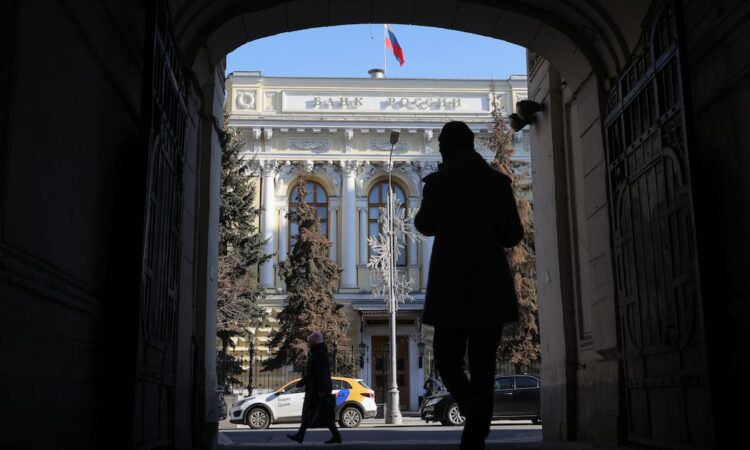
(Bloomberg) — The European Union has presented member states with two options to freeze Russian Central Bank assets for a longer period of time as it seeks to assuage US concerns over a Group of Seven plan to leverage the profits to provide Ukraine with some $50 billion in aid.
The two options are an open-ended immobilization of the assets that would be reviewed at regular intervals, or lengthening the roll-over period to, for example, 18, 24 or 36 months, according to a draft document seen by Bloomberg.
The EU, the US and other G-7 allies have been working to finalize plans to provide Ukraine with $50 billion in loans by the end of the year covered by the future profits generated by the immobilized Russian central bank assets, following an agreement reached at a G-7 leaders’ summit in June.
But the US had raised concerns that the EU’s sanctions regime — which requires an extension every six months by a unanimous vote of 27 member states — could be an problem if the freeze isn’t renewed at some point. Most of the $280 billion immobilized by the G-7 is in Europe.
The US is asking the EU to provide more durable assurances that the assets will remain immobilized, a senior US Treasury official said.
The agreement reached at the G-7 summit envisions the EU and the US providing loans of around $20 billion to $22 billion each, according to people familiar with the matter. The UK, Canada and Japan would contribute with smaller loans.
The proceeds from the frozen assets are estimated to be worth between €3 billion ($3.3 billion) to €5 billion annually. If the assets cease to be sanctioned, each G-7 member would be responsible for covering their part of the financing.
The funds would be used to support Ukraine’s military needs and contribute to the country’s reconstruction.
Some EU diplomats are skeptical that Hungary, which has previously rejected proposals to renew sanctions annually, will agree to the changes, said the people, who were granted anonymity to discuss sensitive talks. Because of those reservations, it’s not yet clear if EU ambassadors will be asked to formally discuss the options when they meet later this week.
Relations between Budapest and the majority of European capitals soured further after Prime Minister Viktor Orban’s self-proclaimed peace missions to Moscow, Beijing and Mar-a-Lago.
Raed more: EU Moves Key Meeting Out of Hungary to Protest Orban’s Diplomacy
Still, the G-7 and the EU have already agreed that the funds will remain frozen until Russia agrees to pay Ukraine for the damage it has done. The European Commission, the EU’s executive arm, is hoping that the bloc will adopt proposals as early as this month to allow its share of the loan plan to be implemented.
A US official said that securing EU assurances on the sanctions regime is indeed an outstanding issue in ongoing discussions. Still, the official was hopeful that a deal will be reached on this issue. The official added that the goal is still to get this money out before the end of the year.
To reassure Washington, European officials note that sanctions against Russia have been in place since 2014 following the invasion of Crimea. EU leaders also included language in a joint statement during their June summit asserting that “Russia’s assets should remain immobilised until Russia ceases its war of aggression against Ukraine and compensates it for the damage caused by this war.”
While some diplomats remain confident that the US will accept European assurances on the stability of the sanctions regime, others remain more skeptical about making enough progress in the coming months given the complexity of the instrument.
Some of the details of the new macro-financial assistance for Kyiv that remain to be finalized include the amount that will be provided and how it would support military spending. The conditionality of the loan program is expected to be linked to the €50 billion Ukraine Facility for 2024-2027.
EU Economy Commissioner Paolo Gentiloni said last week that the starting process of the new aid package for Ukraine is “very urgent” as he is preparing to meet finance ministers of the G-7 in the margins of a Group of 20 meeting in Brazil this week.
He added that the commission would present “very soon” the proposal to structure the part of the EU loan via a macro-financial assistance program.
The G-7 agreement, which frontloads the profits that will be earned by the blocked funds over time, would replace the EU scheme.
–With assistance from Christopher Condon and Viktoria Dendrinou.
©2024 Bloomberg L.P.






